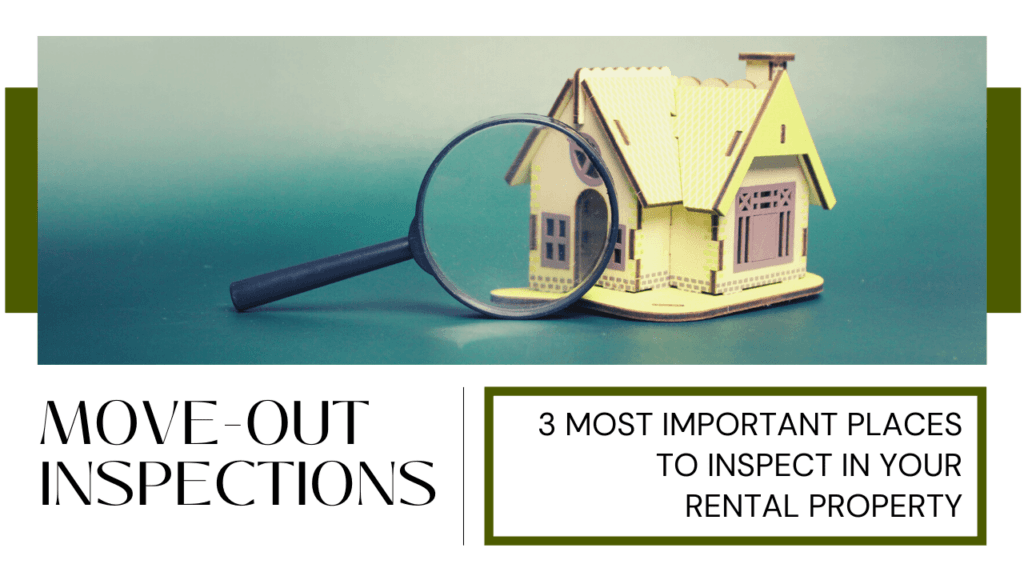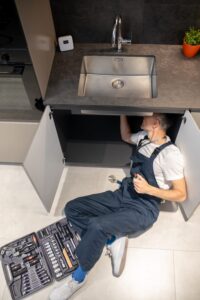
Move-out inspections are perhaps the most important inspections you conduct while renting out a property. This is where you evaluate the condition of your investment and assess whether everything that needs to be repaired is wear and tear (your responsibility), or whether you’ll be making deductions from the tenant’s security deposit for damage.
Because we’re talking about the tenant’s money, California has some strict laws on what you can deduct for and what you need to do to ensure your tenants have every opportunity to get a full refund of their security deposit.
A well-documented move-out inspection will help you when you’re trying to avoid conflict about the security deposit and also protect the condition and value of your property.
We’re going to talk about how to conduct a thorough and legally compliant move-out inspection, and we also want to highlight some of the most important places to inspect your rental property to ensure it stays in good shape and is ready for your next tenants.
Start by Offering a Pre-Move Out Inspection
In California, you are legally required to offer your tenants a pre-move out inspection before they vacate your property at the end of the lease term.
This is an opportunity for both of you.
The tenants can see where you’re likely to make security deposit deductions and they can make as many repairs as they’re capable of making in order to get their money back. The benefit of this inspection for you as the owner is that you’ll be able to see how much time it’s like going to take for you to turn the property over and get it ready for a new tenant.
Tenants do not have to accept this offer, but you do have to make it. If the tenant does request the inspection, you’ll need to schedule it within the final two weeks of the tenancy. Try to pick a date and time where your tenant can be available to walk through the property with you. It’s important to give 48 hours before you enter the property for the purpose of this inspection.
After you’ve done the inspection, provide a list of the things that you can deduct from the tenant’s security deposit. Make sure the documented list of potential security deposit deductions includes legal text that’s found in California Civil Code 1950.5.
Before moving out, tenants can make any of the repairs or changes that their lease agreement allows and requires. There may be things you don’t notice that you’ll later deduct for because the tenant’s furniture or other personal belongings were covering the damage. That’s acceptable. Just make sure you’re following all of California’s laws when you make deductions from the security deposit.
A detailed and well-documented inspection report from the move-in and move-out walk through inspections will help.
Where to Inspect After a Tenant Vacates
Once the tenant has moved out and left keys and a forwarding address, you can get inside the property to do your own move-out inspection. We recommend you do this as soon as possible after your tenant leaves. You only have 21 days to return the security deposit, and you don’t want to waste time turning the property over and renting it out again.
These are the three areas that you really want to focus on when you’re conducting your move-out inspection.
1. Check the Condition of Your Floors
Floors get a lot of traffic during a tenancy. You’ll need to make some decisions about whether you’re clean the carpets, replace the carpets, or perhaps even pull out the carpets entirely and upgrade to hard surface flooring.
California law only allows you to make deductions for tenant damage. You cannot deduct for general wear and tear, which means the scuff marks on floors where furniture was resting cannot be a source for deposit deductions. The worn carpet in certain areas of the home where there is bound to be a lot of walking will also be your responsibility and not the tenant’s.
You can, however, deduct for damage to your floors. This might include:
- Carpet that is torn or stained. If something was spilled and not cleaned up, causing a large stain on your carpet, you can deduct that from the tenant’s security deposit. You might find juice, hair dye, or even paint and ink that have left damage. Large holes and tears in the carpet can also be considered damage.
- Floors that are badly scratched.
- Missing floor tiles.
Lease agreements will often require tenants to have the carpets in their home professionally cleaned before moving out. You can require your tenants to undertake this cleaning at their own expense. Ask for a receipt to show that the cleaning was done by a professional company or with commercial-grade equipment. If tenants fail to do this even though it’s a move-out requirement in the lease, you can do it after they leave and then charge the deposit for the cost of the cleaning.
You’re inspecting the condition of your floors to look for potential deductions, but more importantly, it’s a good opportunity to decide if you’re going to keep those floors or make some upgrades. Carpet is becoming less and less popular in rental properties, thanks to tenants preferring hard surface flooring that’s safer, more durable, and easier to maintain. Consider making this upgrade. It will add to the rental value of your property and attract and retain high quality residents.
2. Look at Your Appliances
All appliances have a general life expectancy, and you need to know if you’re coming close to the point where you need to replace the appliances in your rental property. You also want to make sure tenants did not damage them during their stay in your home.
The move-out inspection should include a complete audit of the appliances you have in your rental home. When you provide an appliance, you’re responsible for maintaining it. If you’ve had to repair the refrigerator three times in the last year, you don’t want to repair it a fourth time. It’s probably a better idea to just replace it.
If there’s a dishwasher door that’s damaged because a tenant’s child jumped on it or an oven that hasn’t been cleaned and is a potential fire hazard, you’ll want to address those issues in the security deposit disposition.
While you’re inspecting your appliances to determine whether they’re in good shape or in need of replacement, check for safety issues as well. The dryer vent, for example, can easily gather enough dust and lint to start a fire. You want to make sure there aren’t any leaks in the fridge or the dishwasher. Turn on the garbage disposal to make sure it’s working and test the microwave, stove, and oven.
Any replacements that you’ll need to make should be purchased right away so you can quickly begin marketing your home to new tenants.
3. Inspect for Leaks and Plumbing Issues
Any inspection at your rental home should include a check for leaks, drips, and any other potential plumbing issues. Water will damage your rental property faster than anything else. If a small leak under a sink or behind a toilet is undetected or ignored, a minor fix will eventually turn into an expensive plumbing repair. When leaks are left alone, they can cause rot and mold. You’ll end up spending a lot more time and money fixing the problem than you would have if you made the repair when it was minor.
Investing in a complete plumbing inspection after your tenants move out is worth your time and money. Not only are you making sure there hasn’t been any damage, you’re also taking preventative measures to protect the condition and value of your property. You don’t want a new tenant moving in if the water heater is rusting and in danger of leaking.
Here are some of the things you can do when inspecting for plumbing problems:
- Turn on each faucet and look for evidence of leaks. Check under sinks and around tubs and toilets to ensure there isn’t any water escaping from pipes.
- Run the appliances to inspect for potential water problems.
- Inspect the water heater and the HVAC unit.
- Look at any irrigation or sprinkler systems to ensure they aren’t leaking, rusting, or malfunctioning.
If you notice any soft walls, floors, or ceilings, or discoloration, it could be due to a leak that’s begun behind the walls or flooring. Bring in a plumber as soon as you can.
 The move-out inspection at your rental property serves several purposes. You’re settling the security deposit and you’re deciding what needs to be done at your property during the turnover process.
The move-out inspection at your rental property serves several purposes. You’re settling the security deposit and you’re deciding what needs to be done at your property during the turnover process.
These three areas require your immediate attention, but they’re not the only places you want to inspect. If you’d like some help managing your move-out inspection process, we have a lot of experience with security deposits and turnovers. We can keep the process efficient and cost-effective. Contact our team at California Pacific Realty.
